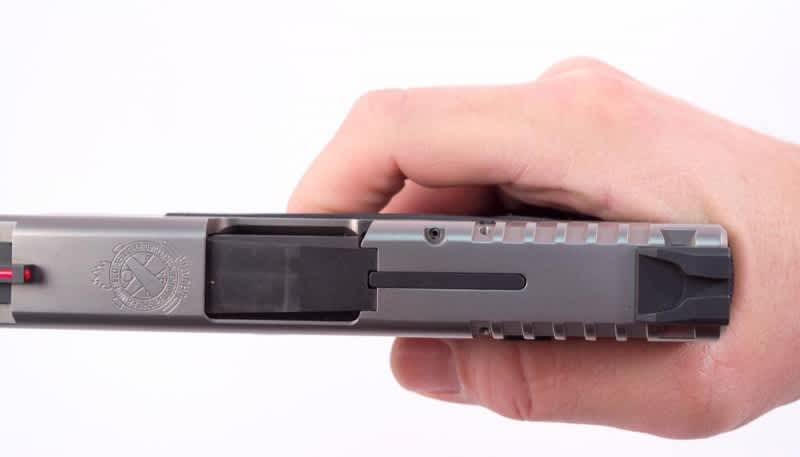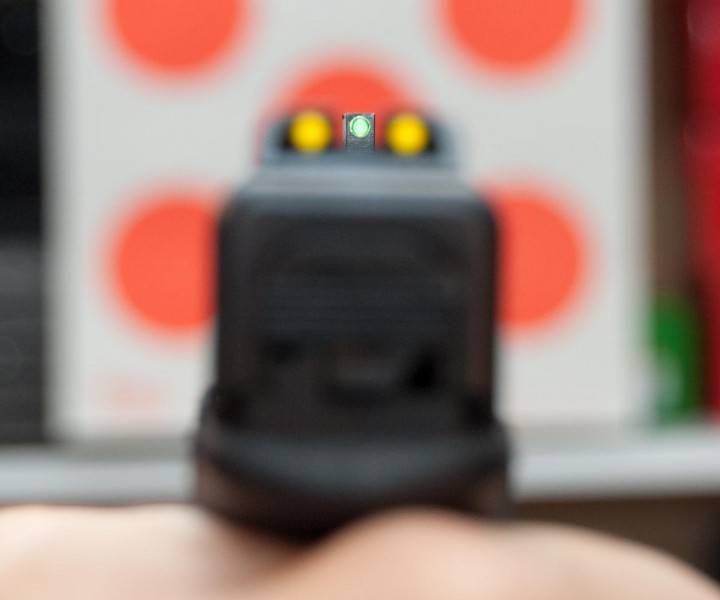Overcome Instinct! Avoid These 3 Natural Shooting Mistakes
Tom McHale 09.17.15

Every time I go to the range, I see new(er) shooters missing a lot of targets. That’s to be expected, as shooting is a skill that, like anything else, requires practice.
Earlier this week, while doing some “work” at the range, it occurred to me that many of the challenges we face as developing shooters are the result of our wiring. Like any other critter, we have natural instincts that have generally served us well over the long haul. Back when we were doing cage matches with saber-toothed tigers, certain instinctive moves were pretty helpful. Also, back when we humans were invented, guns weren’t on the scene, so we didn’t necessarily have any built-in manual of proper handgun operation.
When they pick up a handgun for the first time, especially when it’s without knowledgeable instruction at hand, most new shooters make the same mistakes. These observations aren’t intended to be a criticism against new shooters. It’s more the opposite. I have to wonder if the reason almost all new shooters make the same mistakes is a result following pre-programmed instincts.
Here are three of those wired-in habits I’ve seen and how to correct them.
1. Timing for perfection
When we first start shooting, we have an irresistible urge to achieve perfection. After all, how hard could shooting be? Aim at something, pull the trigger, and hit it. Except we all know that for some reason, it’s never that easy.
If you watch a new shooter, you’ll notice that they aim at the target and at some point, suddenly yank the trigger to break the shot. That’s because none of us are completely steady when holding a handgun—those sights just insist on moving around on the target. When they’re lined up just perfectly, we try to pull the trigger quickly, before the sights move off target. We’re trying to “time” the shot for the exact microsecond that the sights are perfectly aligned.
When you think about it, we’re naturally predisposed to “time” rapid movements. Think about how we perform important activities like swatting flies. You can’t hang around and smack it at your leisure, else that winged demon from hell will be long gone and biting some other part of your body. You have to swat that bug at a precise instant. The same concept probably applied to our cave-dwelling ancestors. When they had to punch a mastodon in the nose, they probably didn’t pause to aim for the left nostril rather than the right. I figure they got somewhat on target and let fly.

When it comes to shooting accurately, you’re better served to forget about the fact that your sights are hovering all around the perfect impact point. The problem with “timing” the shot is that the sudden movement to fire at a precise moment results in a jerky trigger press, which pulls the gun off-target, resulting in a miss. That defeats the entire purpose of trying to aim so exactly! If you can manage to forget about the sight movement and focus a slow and deliberate trigger press, then you’ll hit somewhere within that zone of sight movement. In fact, if you press the trigger properly, you can’t help but to hit inside that zone. It’s guaranteed. As you gain more experience the area of sight movement will become smaller and smaller. While it sounds counterintuitive, you’ll become more accurate by being less precise with your aiming process.
2. Leaning away from danger
One natural instinct that has served us well since rock-throwing days is to lean away from things that threaten to do us harm. When a pterodactyl shoved its beak into the cave, the best defensive play was to move backward. Even now, when someone throws a punch in your direction, the natural instinct is to lean back away from that pending bloody nose.
When you think about it, the body perceives your own gun shot as a potential threat. Heck, a loud and obnoxious explosion is happening right in front of your face. Who wouldn’t instinctively lean away from that? That may explain why new shooters almost always prepare to fire a handgun by leaning backward from the waist, so their head is as far as possible from the boom that’s about to be unleashed. When you remind them to lean forward, more often than not, they’ll thrust their waist even further forward while continuing to lean the shoulders back.
The problem is that a backward posture is totally counterproductive to good shooting. That backward lean offers little control over recoil, so the gun is managing the shooter rather than the shooter managing the gun. To control the recoil of the handgun, the head and shoulders need to press forward into the shot. It’s about as counterintuitive as leaning into a punch, but it’s necessary.
3. Using strength
One of our built-in protection mechanisms is the adrenaline-fueled fight or flight response. When threatened, hormone elixirs dump into our bloodstream and rearrange the priorities of our body. Blood goes to big muscles instead of small ones and is diverted from less-important tasks, like digesting that most recent Brown Sugar Cinnamon Pop-Tart.
Normally, that’s a good thing—either fight or flight will make good use of big muscles. The problem is that really good shooting requires control over tiny muscles, meaning those in your firing hand and trigger finger. A “GRRRR!” grip and trigger pull will almost certainly move the gun off target during the pull itself. That’s because a typical handgun weighs less than the force required to move the trigger.
To make accurate shots, we have to figure out a way to use our big GRRRR! muscles to hold the gun and control recoil while at the same time isolating our small muscles in the hand and trigger finger. In a perfect world, the trigger finger would operate completely independently of the remainder of the body.
What is there to do? I like to think of the right strength of a handgun grip like holding a hammer. You have to hold it tight enough so it doesn’t fly off into the next room when you swing. If you hold it too tight, you’re going to miss that nail because your big muscles have taken over at the expense of control. While you can certainly grip a handgun as tight as you want, you have to disinvite your trigger finger to that “pump you up” party. The most important part of breaking consistently accurate shots is controlling the trigger press so that you don’t pull the gun off-target in the process.
In some ways, the key to good shooting is leaving some of our natural instincts behind. That’s just one of the reasons that getting quality instruction right when you start is so important.
Tom McHale is the author of the Insanely Practical Guides book series that guides new and experienced shooters alike in a fun, approachable, and practical way. His books are available in print and eBook format on Amazon.

